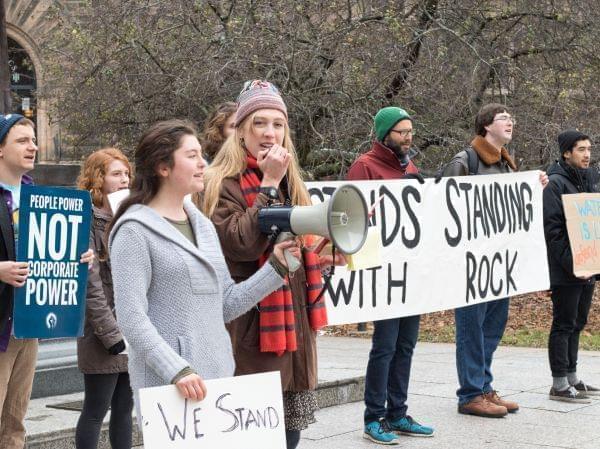Standing together for access to clean water

Members of Students for Environmental Concerns at the University of Illinois rally in support of Standing Rock Sioux. Rob Kanter
Water is life.
So say members of the Standing Rock Sioux tribe and their allies in North Dakota, who seek to halt completion of the Dakota Access Pipeline and name themselves Water Protectors. Among the thousands of Water Protectors are many who have put their bodies on the line and faced violent response from militarized police and private security forces.
Water is life.
So say members of Students for Environmental Concerns (SECs) at the University of Illinois, who rallied last week to show their support for the water protectors. Catherine Yee, who is current co-president of SECs and helped organize the rally, said her group was eager stand in solidarity with others whose access to clean water is threatened and to amplify student voices by bringing them together.
Water is life.
So says Andrew Rehn, water resources engineer who speaks on behalf of Prairie Rivers Network, the Champaign based conservation group that names itself “Illinois’ advocate for clean water and healthy rivers.” Last month, Rehn analyzed the potential impact of the Dakota Access Pipeline in Illinois, where it runs for 180 miles and terminates just a couple of hours southwest of Champaign. Rehn looked at where the path of the pipeline intersects with Illinois EPA designated water supply lakes and river intakes, and calculated that it puts at risk the water supply of more than 27,000 people. He also noted that the pipeline crosses at least 56 named waterways, including some with very familiar ones—the Mississippi, Illinois, and Kaskaskia rivers—as well as streams that are better known only among locals
Rehn also cited an investigation by the Wall Street Journal that looked at how many pipeline spills occurred nationally between 2000 and 2013. How many were there? About 1400—essentially one a day.
Water is life.
So said an incredibly diverse chorus in east central Illinois in recent years, when people here recognized that the Mahomet Aquifer—our water supply—would be at risk if the Clinton Landfill were to accept PCBs for disposal.
That chorus included citizens, scientists, the mayors of Champaign and Urbana, and a bipartisan group of local legislators--state Representative Carol Ammons, of Urbana, state Senator Scott Bennett, of Champaign, and state Senator Chapin Rose, of Mahomet. Beyond that, others who expressed concern about the issue were then-U.S. Representative Tim Johnson, U.S. Senator Dick Durbin, and President Barack Obama himself.
The collective effort of that broad coalition won the designation of the Mahomet Aquifer as a “sole source” aquifer in March of 2015. Sole-source designation recognizes the importance of the aquifer as a source of drinking water to more than half the population of east central Illinois and affords it special protection by US EPA.
The momentum behind the push to protect the Mahomet Aquifer even led to passage of a state law—signed by Republican Governor Bruce Rauner—to safeguard water supplies by banning the disposal of manufactured gas plant waste at most landfills in Illinois.
Water is life.
What distinguishes our water supply, the Mahomet Aquifer, from the water supply of the Standing Rock Sioux Tribe, the Missouri River? On what moral ground do people deny others the right to clean water at the same time they demand that right for themselves?
If you stand among the people of east central Illinois in our fight to protect the Mahomet Aquifer, I would invite you to stand with the Standing Rock Sioux, too.

